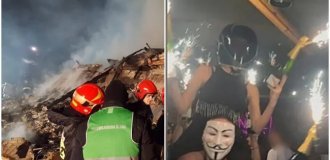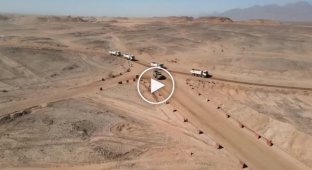Saudi Arabia began to build a megacity of the future in the desert, but something did not go according to plan (16 photos + 2 videos)
Construction has begun in Saudi Arabia on The Line, a futuristic garden city with mirrored facades stretching 170 km. It was planned that by 2030 it would accommodate about 1.5 million residents. However, plans had to be adjusted. 
Line City, part of the bold and futuristic NEOM project, was planned to accommodate some 1.5 million residents by the end of the decade, eventually expanding its capacity to nine million. However, according to the latest data, by 2030 the city-line will stretch only 2.4 km and will have a population of less than 300,000 people. 
First, let's tell you what NEOM is. This is an area in the north-west of Saudi Arabia, in a temperate climate where you can find both sun-drenched sea beaches and snow-capped mountain peaks. 
They are going to create a “region of the future” there, with an airport, a high-speed transport line, an industrial city, a garden city, luxurious sea and mountain resorts, an island resort for yachtsmen... It is planned that this place will become a developing economic zone in which more 100,000 new jobs. 
One of NEOM's projects is the industrial city Oxagon 
Tryam is NEOM's newest project, announced last month. This is a luxury resort complex over the lagoon. With a swimming pool almost 500 meters long
Advertising the Tryam project
And there are more than a dozen such ambitious construction projects in NEOM’s portfolio.
Line City is NEOM’s flagship project, its core.
This is a new look at urban planning: no roads, cars and emissions, convenient public transport, compact infrastructure, everything you need within walking distance, using only renewable energy, ideal climate all year round, 95% of the land is given to nature, building width is no more than 200 m, building height 500 m, high-speed railway. The city should become home to 9 million people and at the same time occupy only 34 square meters. km area.





“THE LINE is an attempt to overcome the current problems of modern cities and offer alternatives. Today's megacities are experiencing crises of improvement and ecology. This situation can no longer be ignored, so NEOM is developing cutting-edge, innovative ways to overcome it. By bringing together the best minds in architecture, engineering and construction, NEOM is making the dream of building high, not wide, a reality.”
His Royal Highness
Mohammed bin Salman, Crown Prince and Chairman of the Board of Directors of NEOM
Promotional video for The Line project
Sounds and looks like a fairy tale, doesn't it? However, sometimes a fairy tale has to face harsh reality.
As a result of adjustments to The Line's construction plans, at least one of the contractors has begun laying off construction workers, Bloomberg reports.
Saudi officials said construction would be carried out in stages and would eventually cover a 170-kilometer stretch of desert along the coast in the western province of Tabuk, with its western end pointing towards the Red Sea towards Egypt. However, those plans have now been cut significantly, by more than 98 percent, Bloomberg reports.
It is unclear whether the Line will still include the twin skyscrapers depicted in concept images, or whether the entire project will have to be reconsidered as its size has shrunk.
Citing its sources, Bloomberg reports that Saudi Arabia has not yet approved NEOM's 2024 budget and that its huge costs are beginning to worry officials. Some Vision 2030 projects are expected to be delayed until the end of the decade.

NEOM was first announced in 2017, and in July 2021, Crown Prince Mohammed bin Salman launched The LINE, attracting the attention of urban planners, architects and the general public around the world.
The huge metropolis, enclosed between two buildings with mirrored facades, 170 km long and 200 meters wide, is intended to be Saudi Arabia's answer to uncontrolled and wasteful urban sprawl.
The promotional materials say that residents will have everything they need within a 5-minute walking distance. And they'll still have access to benefits like outdoor ski slopes and high-speed rail, which can take you to the final stop in 20 minutes.
For the train to cover 170 km in 20 minutes, it must travel at 510 km/h - 25 km/h faster than the Beijing-Shanghai high-speed train at its maximum (it travels at an average speed of 330-350 km/h). But the Beijing-Shanghai high-speed line is one of the fastest railway lines in the world.
Stories that this will be the most convenient city on the planet for living, in which people will not need a personal car, also look like a utopia. As well as plans to use exclusively renewable energy sources.
It's no surprise that The Line - and NEOM in general - has consistently raised eyebrows over its proposed gimmicks like flying taxis and robot maids, with architects and economists questioning its feasibility.

Excavators at The Line construction site, 2022, construction begins
Officials previously said The Line's total population would exceed a million, but Prince Mohammed said the figure would reach 1.2 million by 2030 (other sources estimate 1.5 million) and rise even further by 2045. The promotional video claims that at full capacity, The Line will be home to nine million people.
The incredible figure reflects an expected nationwide population boom that Prince Mohammed says is needed to transform Saudi Arabia, the world's largest oil exporter, into an economic power.
By 2030, the kingdom should be home to 50 million people - half Saudis and half foreigners - up from about 34 million today. By 2040, the goal is 100 million people.
This is the main goal of building NEOM - to increase the capacity of Saudi Arabia, to get more citizens and more people in Saudi Arabia. “And since we’re doing this from scratch, why do we need to copy regular cities?” said Prince Mohammed.

A huge trench for the foundation of a metropolis, 2022
The feasibility of the project has long been questioned.
Architect and urban planner Etienne Bou-Abdo said of concept images for The Line last year that "the 3D images presented are not classic images of 3D architecture" and the project's developers "rather looked to video game designers."

He said the plan includes "a lot of technology that we don't have today." A number of key elements of The Line, especially those related to energy and transportation, are based on technologies that do not even exist in prototype form.

While Saudi Arabian officials are likely to be red-faced at the news that The Line is being scaled back, it will undoubtedly come as a relief to conservationists who have been sounding the alarm about the project's environmental impact.

Last year, experts warned that the huge mirrored surface would become a death trap for millions of birds migrating between Europe and Africa each year. While Saudi Arabia touted the environmental credentials of the finished project, researchers named the construction project itself as one of the 15 most pressing conservation issues to watch in 2024.






























